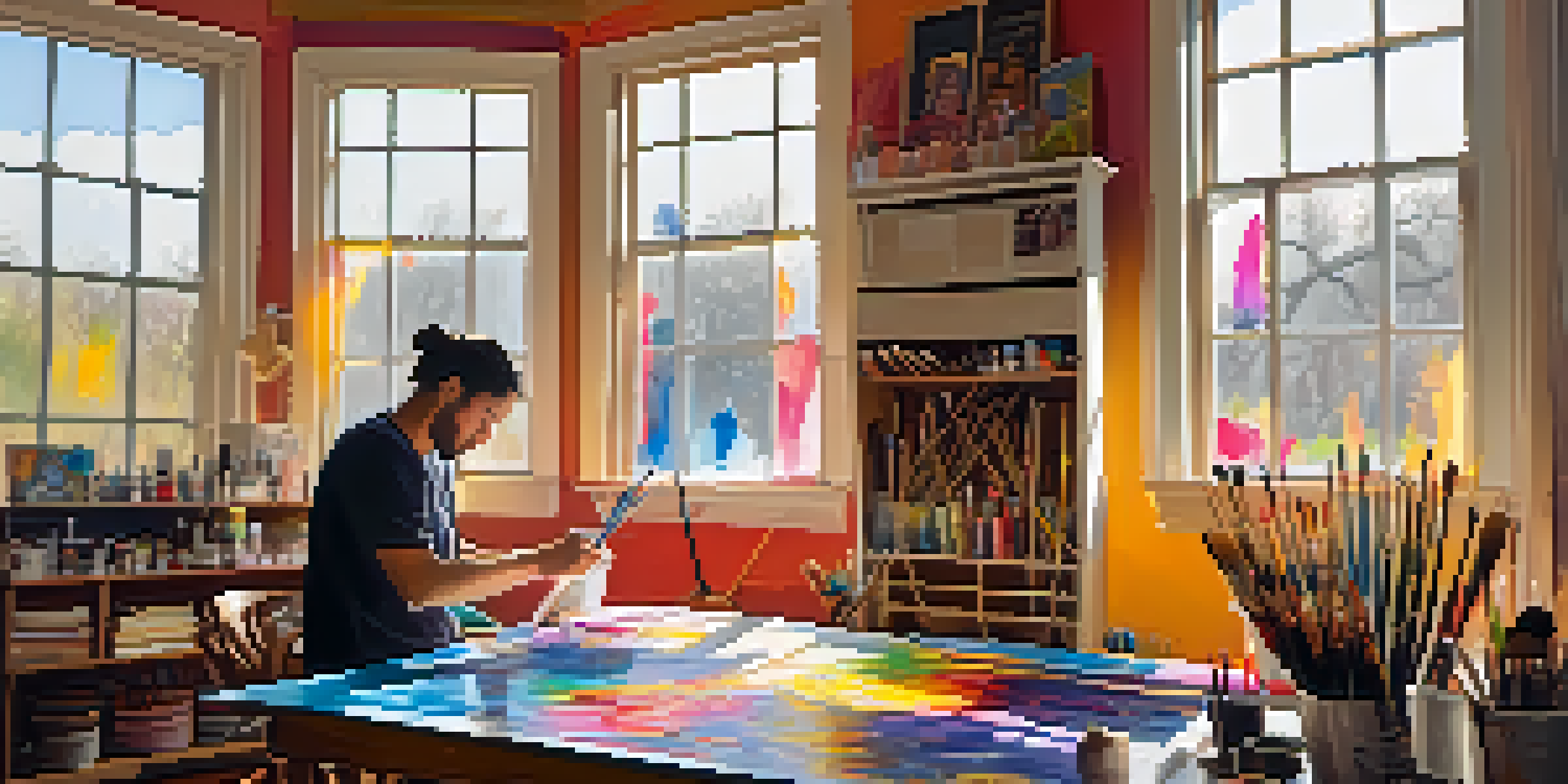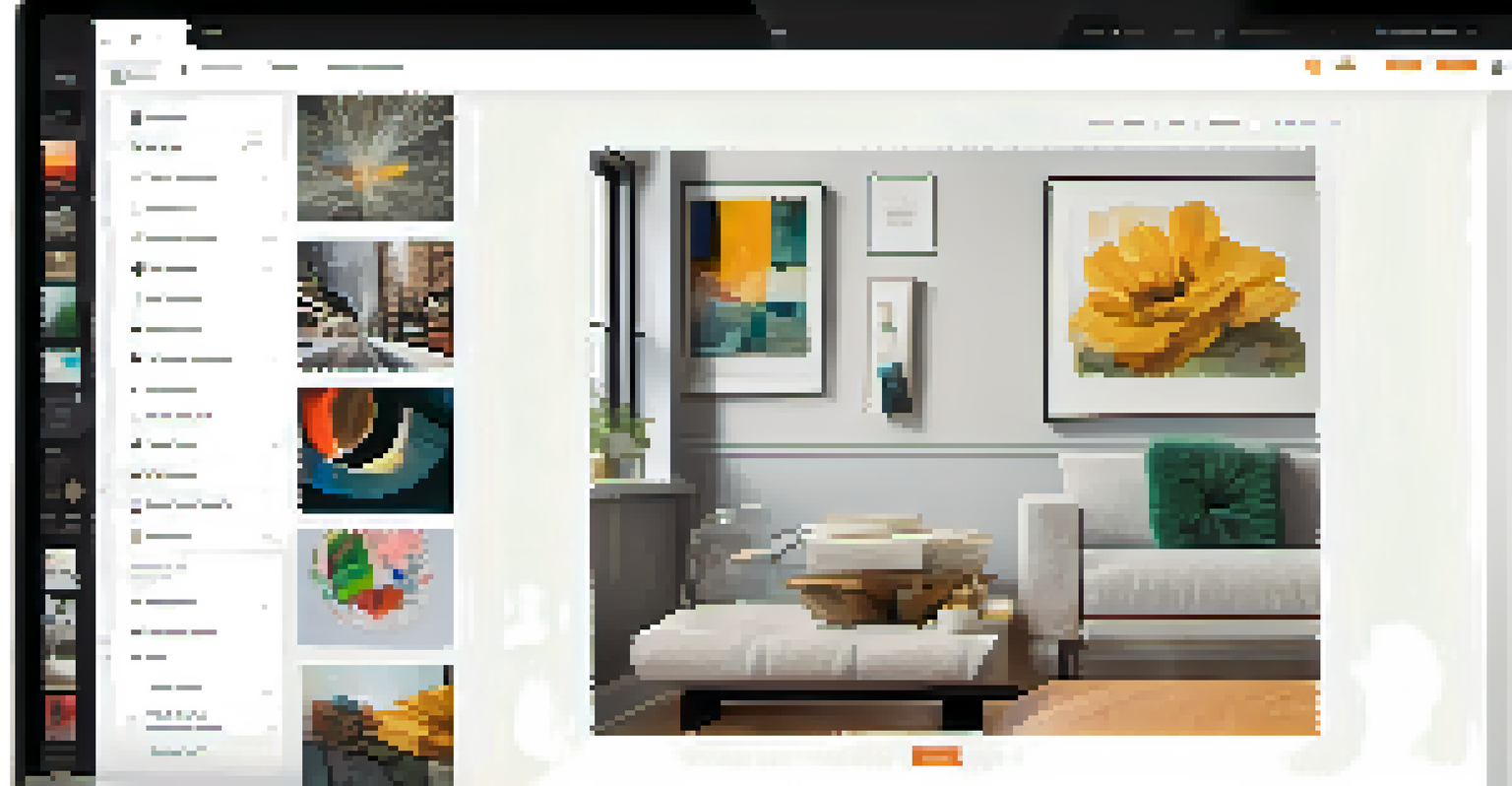Online Art Sales: Navigating E-commerce Platforms

Understanding the Online Art Market Landscape
The online art market has exploded in recent years, becoming a vital space for artists and collectors alike. With the rise of e-commerce, artists now have unprecedented access to global audiences, allowing for a wider reach than traditional galleries. This shift means that understanding the online landscape is crucial for anyone looking to sell art online or grow their collection.
Art is not freedom from discipline, but disciplined freedom.
Platforms like Etsy, Saatchi Art, and Artsy have carved out niches, each catering to different styles and audiences. By choosing the right platform that aligns with your artistic vision or collecting goals, you can significantly enhance your chances of success. It's essential to research and compare these platforms to find the best fit for your needs.
Moreover, the online art market is not just about selling; it’s also about building a community. Engaging with other artists, collectors, and art lovers can create a supportive environment that fosters growth and inspiration. This community aspect can make your online art journey more fulfilling and enjoyable.
Choosing the Right E-Commerce Platform for Your Art
Selecting an e-commerce platform is one of the most critical decisions for artists. Each platform has its unique features, fee structures, and audience demographics. For example, if you create handmade crafts, Etsy might be an ideal choice, while artists looking for high-end collectors might prefer Saatchi Art.

It’s also important to consider user-friendliness and customization options. A platform that allows you to personalize your storefront can help you showcase your unique artistic identity. Take the time to explore different platforms and see which ones resonate with your style and goals.
Navigating Online Art Platforms
Choosing the right e-commerce platform is crucial for artists to effectively reach their target audience and showcase their work.
Don't forget to factor in the cost of selling on these platforms, including listing fees and commission rates. Understanding the financial implications will help you make an informed decision that supports your long-term success in the online art market.
Creating an Eye-Catching Online Art Portfolio
Your online portfolio is your digital storefront, and it must be visually appealing and easy to navigate. High-quality images of your artwork are essential, as they capture the essence of your pieces and entice potential buyers. Consider investing time in photography or hiring a professional to ensure your work is represented beautifully.
The best artist has no conception that a marble block does not contain within it.
Alongside compelling images, it's crucial to provide detailed descriptions of your artwork. This should include the medium, size, inspiration, and any relevant story behind the piece. Such details not only engage potential buyers but also help them connect with your work on a deeper level.
Lastly, keep your portfolio updated with new artworks and remove sold pieces to maintain freshness. An active portfolio reflects your commitment to your craft and can encourage repeat visits from collectors who are eager to see what you create next.
Leveraging Social Media to Boost Art Sales
Social media platforms like Instagram and Facebook have become vital tools for artists looking to promote their work. By sharing behind-the-scenes content, progress shots, and finished pieces, you can create a personal connection with your audience. Engaging storytelling can make your art more relatable and appealing to potential buyers.
Additionally, using hashtags strategically can help your work reach a broader audience. Research popular hashtags related to your art style or niche and incorporate them into your posts. This tactic can increase your visibility and attract followers who appreciate your unique artistic voice.
Creating an Engaging Portfolio
An eye-catching online art portfolio with high-quality images and detailed descriptions is essential to attract potential buyers.
Don't forget to interact with your followers and fellow artists. Responding to comments, participating in art challenges, and collaborating with others can help build a supportive community around your work, leading to increased sales and opportunities.
Understanding Pricing Strategies for Your Art
Pricing your art can be one of the most challenging aspects of selling online. It’s essential to find a balance between valuing your work and remaining competitive in the market. Research similar artworks on various platforms to gauge current price ranges and understand how your work fits within that landscape.
Consider factors such as materials, time invested, and emotional value when determining your prices. It's also helpful to have a clear pricing structure that accounts for different sizes and mediums. This transparency can build trust with potential buyers and make them more comfortable with their purchasing decisions.
Lastly, be open to adjusting your prices based on feedback and market trends. Being flexible and responsive to the evolving art market can help you stay relevant and increase your chances of making sales.
Shipping and Handling: Best Practices for Artists
Once you've made a sale, the next step is shipping your artwork to the buyer. Proper packaging is crucial to protect your art during transit. Invest in high-quality materials such as bubble wrap, sturdy boxes, and clear plastic to ensure your artwork arrives in perfect condition.
Additionally, consider offering multiple shipping options to cater to different customers. Some may prefer faster shipping, while others might prioritize cost-effectiveness. Providing these choices can enhance the buying experience and encourage more sales.
Building a Personal Brand Online
Establishing a strong personal brand helps artists connect with buyers and stand out in the competitive online art market.
Don't forget to communicate transparently with buyers about shipping times and tracking. Keeping them informed throughout the process helps build trust and can lead to repeat business in the future.
Building a Brand as an Artist in the Digital Space
Establishing a strong personal brand is essential for artists selling online. Your brand represents your unique style, values, and story, which can resonate deeply with potential buyers. Consider what makes your art distinct and how you can convey that through your online presence.
Creating a cohesive visual identity across your portfolio, social media, and marketing materials can help reinforce your brand. Use consistent colors, fonts, and imagery to create a recognizable aesthetic that aligns with your artistic vision.

Lastly, share your story! People love to connect with the artists behind the work, so don’t hesitate to share your journey, challenges, and successes. This authenticity can create a loyal following and encourage more sales.